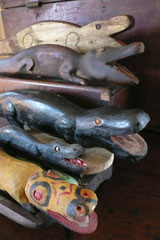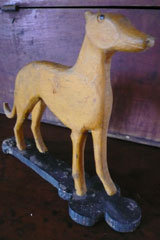
The Folk Art Carvings of Archie ZimmermanA newly discovered American folk artist |
||
"If you've got your hands busy, you've got your mind going."
—Archibald Buchanan Zimmerman
(as told to his great grandson Tom Duncan) Archibald Buchanan Zimmerman was born August 18, 1861 in Plumville, Pennsylvania. He lived for 100 years. My husband and I rescued this collection of folk art in its entirety (minus the later addition of one large white rooster atop a star-shaped base) not too far from Zimmerman’s longtime residence of Jasonville, Indiana. Many of these pieces are dated and show a working span from as early as 1915 until as late as 1955. The stunning joy of finding this collection one day – out of the blue – in rural southeastern Illinois was truly astounding. |
||
Heading home after a long weekend out antiquing, I put my foot on the dash and frustratingly declared that what we needed was to find some "real folk art.” Fifteen minutes later, we pulled into one of our regular haunts. I was combing the aisles methodically for something old and good and rare. Meanwhile, Bob, unusually jumpy, had already sprinted the entire loop around the shop and was tapping my shoulder as I stared at a display of drab gray graniteware. When he could no longer withstand my putzing, he finally stammered that there was something he had brought me here to see. |
||
Begrudgingly, I surrendered my slow-paced investigation and followed him to the back row of cases where there they were – four deep shelves brimming with Archie Zimmerman’s folk art carvings: horses, birds, waving girls in colorful skirts, rams, squirrels, alligators, snakes, spoons, heart shaped bases, Mickey Mouse, and even Herbert Hoover! It took my breath away, and I went weak in the knees. |
||
The shop owner told us the collection, over 100 pieces, was for sale for a single price. Thankfully, she had refused to break up the carvings and had already turned down a generous offer for Zimmerman’s seven wildly painted polychromatic fishing lures. I wanted to take it all with us right then and there, Saturday at 4:45 p.m., the end of the day, but my husband wasn’t so sure. “Heidi,” he cautioned, “we have never bought anything this expensive.” Bob was correct, but I countered that we had never bought anything this good. We decided to discuss the issue over dinner that night. Needless to say, Bob made the call first thing Sunday morning. It was an historic find there was no doubt. |
||
Archie Zimmerman: |
||
The fact that my husband had known about this collection, had actually seen it on one of his trips out and hadn't said anything about it, had let it sit out there – available for two long weeks – just shows his naiveté (he's a relative newcomer to the antiques world; so I have to forgive his inexperience occasionally). The fact that this collection wasn't swept away by someone else traveling down the interstate and making a stop at an established country antiques shop is, for us, simply a stroke of stupid luck. The Zimmerman collection is a once in a lifetime, a never in a lifetime, find. The wide scope of this large body of carvings, done by a man who lived for a full century, stands as a powerful and lasting example of Pennsylvania German folk art pulled straight from its source. This much is clear from the start: Archie Zimmerman is to Jasonville, Indiana, what Wilhelm Schimmel is to Carlisle, Pennsylvania. |
||
The charming grace and naive nature of Zimmerman’s carvings is undeniable. The sophistication of his themes is surprising and delightful. Zimmerman, like Picasso, had also visited Mexico. Archie’s horned bulls (one actually sports a small set of real horns) with wide primordial red- and black-rimmed eyes echo Picasso’s work of the day, yet Picasso and Zimmerman couldn't have been more different or farther apart. Pablo Picasso was a world-renowned artist who spent his life learning to draw like a child, and Archie Zimmerman was a small town Indiana coal miner who never lost his childlike artistic exuberance. Picasso sold his work for top dollar to art lovers across the globe. Zimmerman would give his sculptures to any Jasonville child who requested one. |
||
Zimmerman was influenced by popular culture. For instance, a painting of Mickey Mouse adorns one of Archie’s hanging match holders. Warhol would have loved this piece. A large carving of President Hoover dated 1931 shows Zimmerman’s political stance. Archie was also fascinated with exotic animals. A lovely giraffe bench, several alligators, a flamingo, and a wonderful carving of two gorillas stand out in the collection. What really demonstrates Archie's obvious Pennsylvania roots, however, is the abundance of farm animals and other local fauna: horses, roosters, dogs, cats, songbirds, snakes, and squirrels. These are the pieces that show Zimmerman’s colorful vision of nineteenth century rural America and place his work squarely into the Pennsylvania Dutch folk art tradition. Zimmerman was born into Lincoln’s America and lived into Kennedy’s, and his work bridges this wide gap and bonds these centuries together. |
||
  |
||
  |
||
Bob and I are still in the beginning stages of researching Zimmerman’s early life and his ancestral chain; thus, many holes in the long Archie Zimmerman story remain. For the record, here is what we know. Zimmerman was born in Indiana County, Pennsylvania, in 1861, not long after the onset of the civil war. We do not know the names of Zimmerman’s parents or how long young Archie resided in the rugged coal mining countryside of southwestern Pennsylvania. |
||
On April 20, 1886, in Hopkins, Kentucky, Archie married twenty-two-year-old Kentucky native Nancy Jane “Janie” Durham. Archie and Janie’s granddaughter Wanda Duncan, who recently celebrated her eightieth birthday, and her son Tom Duncan note that Archie and Janie escaped the coal mining town of Hopkins under the cover of darkness and lived in several places out west until they finally settled in Jasonville, Indiana, in 1903. They would raise eight children and one grandchild and remain married for the rest of their lives, until Archie’s death in 1961 at age 99 ½. Nancy Jane would follow shortly thereafter, herself 98. They are still together, buried side by side in a small cemetery on the outskirts of Jasonville. |
||
Driving over to Plainfield, Indiana, one rainy Sunday to meet Wanda Duncan was another unbelievable gift. I hoped Archie’s family wouldn't be resentful that we had this work and what seemed like so many pieces of it. Luckily, Wanda and her husband were extremely gracious hosts and shared their knowledge with us. To my delight, Wanda showed us a colorfully painted squirrel on top of a sewing caddy, with a little drawer and all – unmistakably Archie. |
||
On our next visit, we would go into Indianapolis and meet Zimmerman’s great grandson Tom Duncan and discover even a few more jewels of Archie's – a folk art gun, a small curled up snake ready to strike, and a charming pair of woodpeckers on a branch. We would learn what I thought was a watering trough for horses was actually a pipe rest. |
||
  |
||
Perhaps the finest testament of Archie Zimmerman’s legacy is Tom Duncan himself. Tom is a highly trained musician who carves his own harps. He learned the art of carving from his great grandfather, who taught him to whittle spoons. Duncan also makes intricate paper cuttings, highly detailed embroidery, and expressive figural pottery. It is through Tom Duncan, a talented folk artist in his own right, the Zimmerman artistic gift lives on. |
||
Duncan tells us that his great grandfather could make a piece in a day’s time and that Archie gave out much of his work to family, friends, neighbors, and children. Since Zimmerman carved for several decades, there are bound to be more of his carvings in existence. Bob and I are actively seeking information on Archie Zimmerman’s life and his ancestry. We are also looking to document or purchase additional Zimmerman carvings. Our purpose with this project is to construct Archie’s life story and to share his magnificent body of work with the public through our website, through any articles written on Zimmerman, and through any possible museum exhibitions. We believe the Zimmerman collection is a truly important discovery in the world of American folk art, and it is our goal to help put Zimmerman’s work on the map and help give Archibald Buchanan Zimmerman the recognition he so richly deserves. |
||
We hope you enjoy our photographs of the Zimmerman collection. Please don’t hesitate to contact us if you have any questions about the collection or would like to share any information on Archie Zimmerman or his work. |
||
contact usBob Zordani & Heidi Kellner: (217) 714-5016, Champaign/Urbana, Illinois: zandk@zandkantiques.com |